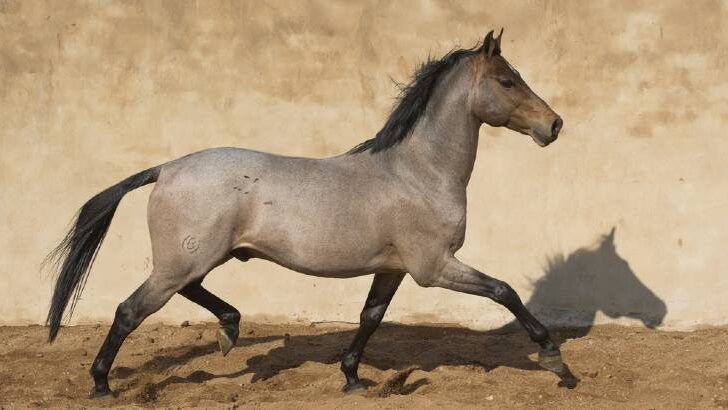Affiliate Disclaimer
As an Amazon Associate I earn from qualifying purchases. It helps me keep the website going. Thank you for your support.
What is a strawberry roan horse and what does one look like? In the article, we explore the colorful world of strawberry roan horses. We explain what they look like, how you can breed one, what one costs, and what breeds you’ll find the color in.
A strawberry roan is a chestnut horse that has an inherited genetic variant in a gene (KIT) that is involved in pigment distribution. The variant causes white hairs to be interspersed throughout the under coat of the horse. This is called ‘roaning’ and it produces the characteristic pinky-white frosted look of the strawberry roan with its red points.

Genes and The Strawberry Roan Horse
Like all horses, roans are one of 3 base colors – bay, black, or red (chestnut). Strawberry roans are genetically chestnut + a roan variant of KIT. Here are some other basic genetic points about roans in general:
The Roan Gene
- Roan is completely unrelated genetically to both grey and varnish ‘roan’ in appaloosas, although the latter can produce a similar phenotype.
- Homozygous roan is now proven to NOT be in utero lethal. (source)
- Roan is a coat pattern, not a dilution.
- Roan is dominant; a horse that carries it will express it. Only the extent to which it does so varies.
- Roans go darker in winter as the longer base-colored coat hairs hide the white under coat hairs. (source).
- The points on a roan likely remain dark because these areas don’t have much under coat and thus don’t get the white hairs.
- Roans can also carry dilution and other coat pattern genes, meaning palomino roan tobianos, buckskin roan frame overos, etc do exist.
- Not all roans are genetically identical when it comes to their roan DNA coding. There are in fact several different known variants in the applicable section of DNA code within the KIT gene, all of which create the roan phenotype.
- Roan thoroughbreds for example have a different roan variant to roan Quarter Horses. Roan Welsh ponies have a different variant again as do roan Shetland ponies and Gotlands. None of the previously identified roan variants were found in roan Icelandic horses. (source) And so on. In fact, because the KIT gene is very prone to spontaneous ‘mutations’, it’s highly likely there are many more roan variants than the handful we currently know about.
- The roan variant in Quarter Horses is often referred to as ‘classic roan’, a term that was originally coined to differentiate between ‘true’ genetic roans and other similar, but genetically different, coat patterns.
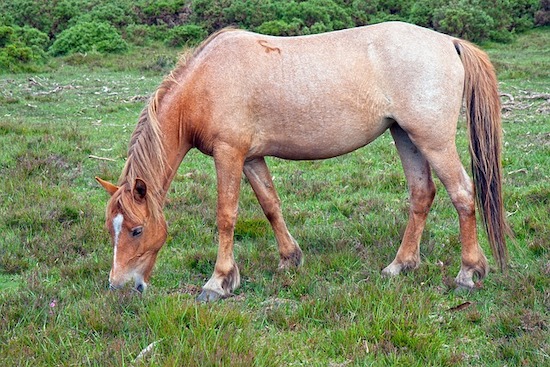
Genetics Terminology – A Quick Guide
Confused about genetics terminology? Here is a basic explanation of the most common terms you’ll find throughout this article:
Phenotype:
‘Phenotype’ is what the horse looks like on the outside.
Genotype:
‘Genotype’ is what it is on the inside i.e. its genetic makeup. Sometimes this is visible on the outside. Sometimes it’s not. People with brown eyes for example may carry the DNA coding for blue eyes but because this coding is recessive to the coding for brown eyes, their eyes are brown (phenotype).
However, they can produce blue-eyed offspring if the other parent either has blue eyes or has similar ‘hidden’ DNA coding for blue eyes.
Genetic Variant:
A genetic ‘variant’ is a change in DNA coding from the wild type or primitive DNA coding that doesn’t result in disease. It’s also relatively recent terminology – previously they were called ‘mutations’.
Genetic Mutation:
A genetic ‘mutation’ is a change in DNA coding that results in disease. One example in horses is the mutation in the ENDRP gene that causes lethal white overo when 2 copies are present. This is similar to Hirschsprung’s Disease in humans.
Variants and mutations are ‘typos’ if you like in the DNA sentence that can completely change the meaning of the sentence. A bit like typing ‘mat’ instead of ‘cat… So – if a sentence is meant to say ‘the cat and the hat’ and you typed ‘the mat and the hat’ you’ve gone from a feline and a hat to a mat and a hat. One simple typo = a different sentence. It’s the same with DNA sentences.
Wild Type
‘Wild type’ refers to the original DNA coding for a species. All characteristics that are a departure from the original wild-type version of an organism are caused by variants, or changes, in DNA coding.
The ancestors of the domestic horse for example were originally ALL solid bay duns. Over time, variants in the DNA coding at various genes involved in pigment production and distribution produced different coat colors and patterns.
Humans then selectively bred for these traits, which helped spread them amongst the general horse population. This is why we have such a wide range of coat colors and patterns in our horses today.
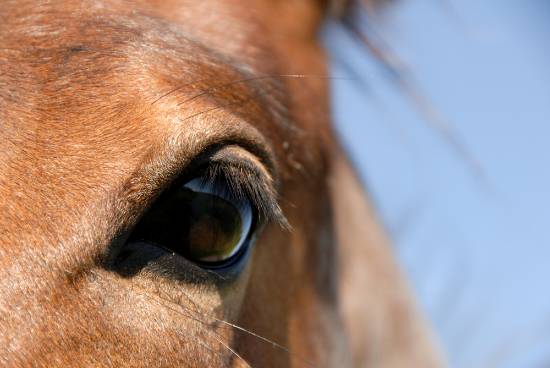
How Roan Variants, Like Strawberry Roan, Happen
Genetic variants like roan usually occur spontaneously when DNA from the parents’ genes is replicated at conception. When this happens in a gene involved in pigment production and distribution, like the KIT gene, it can produce a new and unique characteristic in that particular offspring. That individual can then pass the genetic variant on to their own offspring.
The best-known example of this in the world of roans is the very recent variant that occurred in the Thoroughbred stallion Catch A Bird. He was born bay with vertical white stripes and spots ‘dripping’ down his torso from his spine. No other horses in his pedigree had the trait, so it was something that happened spontaneously in him.
Catch A Bird’s offspring who inherited the trait though presented as typical roans, which told geneticists what it actually is genetically. Namely, a variant in the DNA coding in his KIT gene that somehow created solid ‘bird dropping’ like markings on him but created typical roan phenotypes in his offspring.
Why Are There Different Names For Chestnut Roans?
You’ve probably come across names like ‘sorrel’, ‘liver’, and ‘black’ in relation to chestnuts.
These are all examples of how we humans like to name things – in this case, the different shades of chestnut! This habit has carried over into the similar use of names for shades of chestnut roan. So you’ll find terms like ‘strawberry’ and ‘red’ usually (but not always) refer to different shades of chestnut roan. In particular – ‘strawberry’ often refers to light and flaxen chestnut roans due to their light pinkish ‘strawberry’ color.
Regardless, the correct name today for all chestnuts with roan, and the one used by geneticists, is ‘chestnut roan’.
What’s The Difference Between A Strawberry Roan And A Red Roan Horse?
But – tradition being what it is – in some places, and in some breeds, the lighter shades of chestnut roan are still called ‘strawberry roan’ to differentiate them from the darker shades, which may be referred to as ‘red roan’.
Alternatively, ‘strawberry roan’ can also refer to chestnut roans in general, whilst (confusingly) ‘red roan’ can refer to roans with a red body and black points i.e. roan on bay.
NB: Geneticists now refer to roan on the bay as ‘bay roan’ to remove any ambiguity about base color. However, a quick Google search will find sites that still tell you a ‘red roan’ has black points!! ‘Red’ though is most correctly used to refer to chestnuts, or red-based, horses.
Nevertheless, the use of traditional names like ‘strawberry roan’ can take decades to disappear. Sometimes they never do!
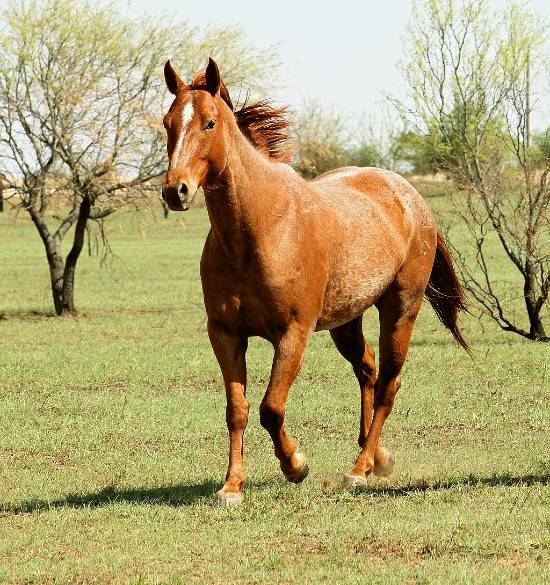
Betty Wills (Atsme), CC BY-SA 4.0, via Wikimedia Commons
What Does A Strawberry Roan Horse Look Like?
Most chestnut roans have a pinkish-red body in varying shades of pink, with a red head, legs, mane, and tail. How light or dark they are depends on the shade of chestnut they are.
Broadly, chestnut coat shades come in:
- Flaxen chestnut – geneticists believe ‘flaxen’ is a distinct genetic trait in its own right because it often breeds true (source). Therefore, unlike other colloquial names, ‘flaxen chestnut’ is correctly used to describe chestnuts that carry the genetic variant that causes the coloring instead of simply being a light shade of chestnut.
- Light chestnut – may also be called sandy or blonde chestnut
- Regular chestnut – may be called cherry or red chestnut
- Dark chestnut
- Very dark chestnut – usually called liver chestnut but may also be called ‘black’ chestnut
The Use Of The Name ‘Strawberry Roan’
If you use strawberry roan to describe light chestnut or flaxen with roan, then the body of a strawberry roan horse has a lighter ‘pinker’ tone than the darker ‘red roan’ shades, courtesy of its lighter chestnut base color. The head, legs, mane, and tail are also lighter than those of red roans, and may even be flaxen.
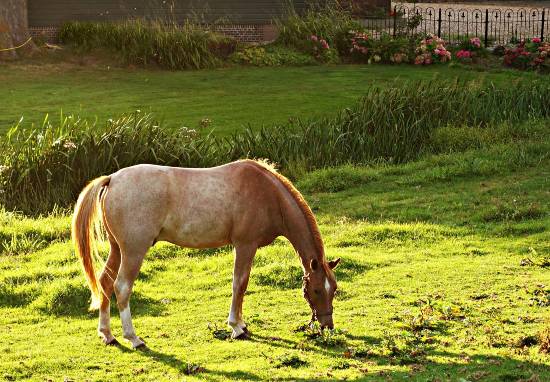
Other Factors That Influence What Chestnut Roans Look Like
Several other factors also influence the overall appearance of a chestnut roan.
- The density of the white hairs throughout their coat can vary quite a lot. The denser these are, the lighter (or pinker) and more ‘frosted’ the body looks. The less dense they are, the more ‘red’ the horse will look. Minimal roans for example have very few white hairs. Some may be so ‘minimal’ they’re only identified as roans when they produce noticeably roan offspring from non-roan partners. The ‘minimal’ chestnut roan Australian Quarter Horse stallion Genuine Roy is an excellent example of this. For all intents and purposes, he looks like a regular chestnut Quarter Horse!
- White hairs in roans can also vary in distribution across the body. Some roans are evenly ‘frosted’ whilst others have a more ‘blotchy’ appearance with areas that are more heavily roaned than other areas.
- Strawberry and chestnut roans will have red ‘corn’ marks where they’ve been branded, or have old injuries. The scar tissue left behind by these injuries doesn’t seem to grow an under coat, so will always grow back the base color of the horse, which in the case of chestnut and strawberry roans, is chestnut. Or red…
- All roans have an inverted ‘V’ on their front legs just above the knees where the darker color of their lower legs meets the lighter color on their forearms. In chestnut roans, this ‘V, like their lower legs, is red. Unless they have white leg markings…
Chestnut / Strawberry Roan Color Variations
Broadly, chestnut roan colors include:
- Flaxen chestnut – a very light pink body with a flaxen mane and tail.
- Light chestnut – slightly darker pink body with a redder mane and tail than the flaxen.
- Regular chestnut – pink body that is darker than either of the other 2 shades but not as rich or dark as dark or liver chestnut roan. The head and points will be regular chestnut in color.
- Dark chestnut – darker pink body with dark chestnut head and points.
- Liver chestnut – dark pink body with very dark, almost black looking, head and points.
How To Get A Strawberry Roan Horse
If you want to breed a chestnut/strawberry roan, you’ll be happy to know that if you only use chestnuts (and chestnut-based colors like palomino, cremello, red dun, gold champagne, etc) for breeding, you’ll always get chestnut-based offspring! This is because chestnut is recessive to bay and black so, like all recessives, recessive (chestnut) to recessive (chestnut) will produce 100% recessive (chestnut and chestnut-bases).
Note – because we are talking about chestnut and strawberry roans, we are referring to chestnuts in this section unless otherwise specified.
How To Get A Strawberry Roan: Step 1
Use a chestnut mare and a chestnut stallion.
How To Get A Strawberry Roan: Step 2
Add roan to the mix.
To get a chestnut roan, you need to make sure at least one parent is also roan. This will ensure your foal is either chestnut or chestnut roan.
However, if you’re hoping for a lighter shade of chestnut roan, we are only just beginning to understand how shades work in terms of inheritance. Two regular chestnuts for example won’t necessarily produce a regular chestnut foal when bred together.
Likewise, a light chestnut may produce a dark chestnut. And vice versa. Therefore, although your foal from a chestnut and a chestnut roan will be either chestnut or chestnut roan, it could be any shade of chestnut, or chestnut roan!
If you want a guarantee of a chestnut roan foal (and most breeders like ‘guarantees’!), things start to get a bit more technical. One parent will need to be homozygous for roan. If it is, ALL its foals will be roan (and chestnut roan if the other parent is also chestnut). The only way you’ll know this though is by DNA testing for roan.
These are your chances (%) of getting a chestnut roan foal using chestnut-based parents:
- Chestnut x chestnut roan – 50 / 50 chance of chestnut roan/chestnut
- Chestnut roan x chestnut roan – 75 / 25 chance of chestnut roan/chestnut respectively
- Homozygous chestnut roan x chestnut / chestnut roan – 100% chestnut roan
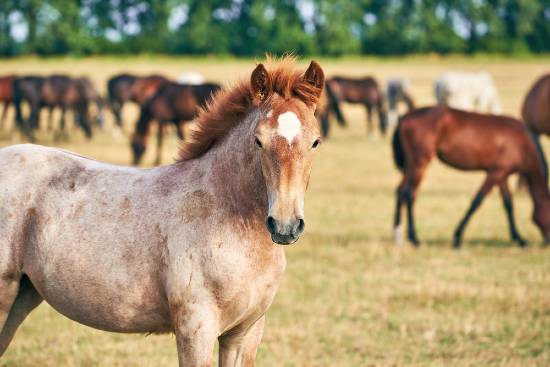
Can I Use Another Base Colour Roan To Get A Strawberry Roan Horse?
Yes, you can but you may not get a strawberry/chestnut roan…
If you can find a bay or black roan that is homozygous for roan and use that with a chestnut, you’ll get a roan foal. However, because bay and black are both dominant over chestnut, you could get a bay, black, or chestnut roan depending on the color genetics of the bay or black parent.
What do I mean by this last comment?
Well… IF your bay or black roan parent carries 1 copy of the right combination of ‘pigment switches’ that produces chestnut, you have a 50% chance of getting a chestnut roan. IF your bay or black roan parent doesn’t have this, your foal will be bay or black roan.
In most cases, you’ll only know all this by DNA testing to find out what combination of ‘pigment switches’ the horse carries.
Note: if a bay or black horse has a chestnut parent then it will have 1 copy of the right DNA needed to produce chestnut. You just can’t see it because it’s hidden by the bay or black.
What Are Some Strawberry Roan Breeds?
Although you’ll find roan in a large number of breeds, it’s more common in some breeds than others. Notable examples include:
- Quarter Horse,
- Peruvian Paso,
- Paso Fino,
- Standardbred,
- Mustang,
- Missouri Fox Trotter,
- Tennessee Walking Horse,
- Morgan,
- Australian Stock Horse,
- Australian Pony,
- Australian Brumby,
- Riding Pony,
- Some European Draft breeds,
- Miniatures,
- Welsh pony,
- Dales pony,
- Gypsy Cob,
- Connemara,
- Shetland,
- New Forest pony
There are no documented roans in purebred Arabians, and it’s only found in one line of Thoroughbreds that trace back to the New Zealand-bred, Australian-owned stallion Catch A Bird.
The color is also reasonably rare in Icelandics (0.5%); roans in this breed usually trace back to just a couple of stallions. (source)
How Much Does A Strawberry Roan Horse, Or Pony, Cost?
You don’t ride the color… Or words to that effect!
What this means is that a horse shouldn’t necessarily be more expensive just ‘because’ it’s a particular color. Granted, some colors are rare and only found in a few breeds, making them harder to breed. In these cases, you would expect to pay a bit more for the color. Roan however isn’t one of them, unless it’s also a breed in which the color is rare, like Thoroughbreds.
However – thoroughbreds per se are bred to race. If the roan doesn’t have a successful, or popular, racing pedigree then realistically it’s not worth any more than other Thoroughbreds with similar pedigrees (except to someone who specifically wants a roan Thoroughbred…)
You can get well-bred, even successful, Thoroughbreds straight off the track for as little as $0… At the top end of the scale, elite racehorses are worth millions.
With that in mind, let’s have a quick look at what some of the most popular breeds with roans cost:
Cost Of Quarter Horse Roans
In breeds where roan is common, like the Quarter Horse (and Welsh pony), it’s not unusual to find specific lines of roans that ALSO come from extremely popular, or good working lines. These horses are usually expensive courtesy of their pedigree, not necessarily because they’re roan!
Generally, you can expect to pay anywhere from $500 to $100,000 US for a Quarter Horse, averaging between $1,000 and $10,000 US. A roan from a good family or with a proven performance record may cost towards the upper end of that range. One that’s not will (or should) cost considerably less.
Cost Of Welsh Pony and Cob Roans
A good Welsh pony averages between $5,000 and $50,000 US, although you may have to pay double that for good breeding stock from popular lines. Roans in the more popular lines will cost around the same as non-roans in those families, and for the same reasons as Quarter Horses.
Apart from these, most of the breeds on the list above average between $2,000 and $10,000 US with exceptional stock costing more. You would therefore expect the cost of a chestnut/strawberry roan horse of these breeds to be within the same range as non-roans with the same pedigree, training, and performance record.
In other words, if we take out color of the equation, the cost of a chestnut/strawberry roan horse should be determined by its breed, pedigree, temperament, and performance history. If these are average, the price of the horse should reflect that. Don’t get caught in the trap of paying the same (or more) as you would for a better quality horse just because this ‘average’ one is a ‘pretty’ color!
Final Thoughts
The chestnut, or strawberry roan horse is an attractive pinkish, or ‘strawberry’ colored horse. It has white ticking in the under coat across its torso, whilst its head, legs, mane, and tail are whatever shade of chestnut it is. Chestnut roans are found in many breeds but are more common in some than others.

